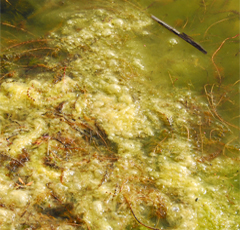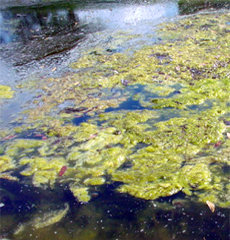|
The most common troublesome algae are species of cyanobacteria are:
* Oscillatoriales - filamentous, non endo/exospore-producing; incl. Oscillatoria, Lyngbya, Anabaena
* Microcystis
* Cylindrospermopsis
* Aphanizomenon
* Nostoc: A fine, filamentous cyanobacteria that can form spherical colonies.
Product information on - Eutro-Clear- for nutrient reduction in eutrophied ponds
Product Sales for Eutro-Clear
|
|
- Oscillatoria
- Lyngbya
- Anabaena
- Cylindrospermopsis
- Photo
Oscillatoria
Long blue-green, unbranched filaments that oscillate naturally. Most tolerant of organic pollutants. Oscillatoria spp. often inhabits depths of thermally stratified lakes in which gradients of physical and chemical factors occur. Often found with Euglena in waters with high nitrogen levels. Common in farm ponds and lagoons where sewage is treated. O. pubescent is a red species that can form conspicuous red blooms in eutrophic lakes. Some species of Oscillatoria are known to produce toxins. These include both neurotoxins called anatoxins and hepatotoxins called microcystins. Anatoxins can block the transmission of signals from neuron to neuron and neuron to muscle, while microcystins cause bleeding in the liver. The threat is more to livestock then to humans.
Lyngbya
This is a species which is particularly troublesome to control using traditional copper sulphate and chelates. They grow in colonies forming small spongy masses of mucilage. These blue-green, black or gray clumps made up of thousands of individual cells will lie on the bottom or float to the surface. Because of its protective mucilage, chemical control is difficult.
Lyngbya is one of the groups of cyanobacteria that are of special concern. This long, hair-like organism is a filamentous alga that can form large benthic (on the bottom) and surface mats (blooms). Lyngbya normally grows in dense mats at the bottoms of nutrient enriched lakes and spring fed systems. These mats produce gasses during photosynthesis that often causes the mats to rise to the surface. At the surface, winds pile the algal mats against shorelines or in navigation channels; these mats can be several acres in size. Lyngbya is one of the cyanobacteria that are known to release toxins into the water. These three toxins, debromoaplysiatoxin, aplysiatoxin and lyngbyatoxin have been found to be a major cause of dermatitis.
Anabaena (ann uh BEE nuh)
this cyanobacteria is capable of causing odor even in small numbers. It can form surface scum, where concentrated cells can be drunk by livestock. Produces toxins that can cause skin rashes in humans and has been known to cause death to livestock drinking infected water.
Microcystis (MIKE row sis' tis) is an important bloom-forming cyanobacter. This spherical, unicellular algae can form a colony (group of cells). Though microscopic in size, when in bloom proportions, it will turn the water a blue-green color and may form surface scum. Some strains of Microcystis have the ability to produce a toxin known as microsystin. In abundance, this toxin is potentially harmful to animals.
Cylindrospermopsis
This tropical algae, Cylindrospermopsis, is found in rivers, freshwater lakes and ponds and reservoirs. This particular species grows abundantly and blooms in subtropical freshwater lakes and rivers with high levels of phosphorus and other nutrients.
Unlike Anabaena or Microcystis, the cells of Cylindrospermopsis are extremely small and do not form surface scum. It does produce a brown tint to the water, but cannot be easily distinguished from suspended sediment or other types of algae that also appears brown, such as diatoms. The algal cell densities may be very high, in the hundreds of thousands per millilitre, and located in bands several feet from the surface in a lake, stagnant pond or slow moving water. There is no taste or odor associated with Cylindrospermopsis or its toxins
Like others in this group, Cylindrospermopsis produces oxygen by photosynthesis and can fix nitrogen from the air and so can live without relying on nitrogen sources in the water. In recent years, this species has begun replacing other bloom-forming algae as the dominant alga following the nutrient enrichment of lakes, reservoirs, and rivers. There is now evidence that it appears to be moving into more temperate climates.
Cylindrospermopsis is very small, even in comparison to other microscopic algae, and is made of a filament that is either linear or coiled and composed of rectangular cells with basal heterocyst’s (nitrogen fixing cells).
Cylindrospermopsis, when found in large quantities, can produce several substances that show toxicity, including:
- Cylindrospermopsin, which is mainly toxic to the liver, but can affect the kidneys, heart and other organs, and may be carcinogenic and genotoxic;
- Saxitoxin, which is a neurotoxin that can cause paralytic fish poisoning leading to paralysis and respiratory distress in fish eaters; and
- Anatoxin-a, which is a neuromuscular agent that can result in paralysis, respiratory distress and convulsions.
Lyngbya

|


